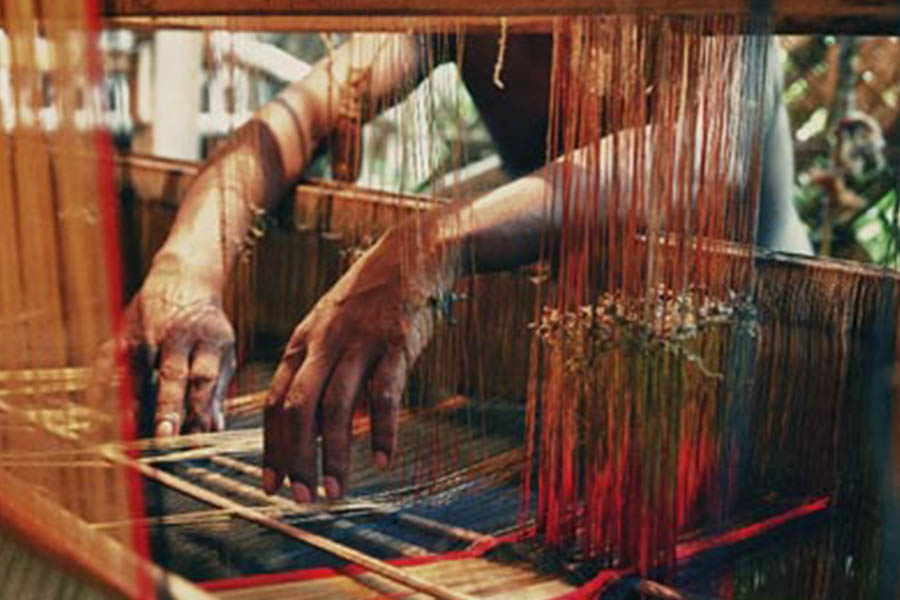Nearly-forgotten fabrics of India
When we think of sarees, the names ‘Kanjivaram’ and ‘Banarasi’ immediately pop into our minds. These sarees have no doubt put the Indian textile tradition on the global map. But there are many other weaving styles and fabrics that the country boasts of—Ilkal, Khandua and Ajrakh to name a few. They may not be household names, but they are as intricate, gorgeous and soulful as the celebrated silks.
Over the years, due to the changing market dynamics and the rise of cheaper power loom fabrics, the demand for these age-old fabrics have declined. But thanks to revival efforts by saree patrons, designers and cooperatives, some of these weaving techniques have managed to survive from their languishing fortunes. Of course, much more needs to be done to revive the nearly-forgotten fabrics of the country. And that can happen only when more consumers come forward and make these fabrics a regular part of their wardrobes.
Let us look at the lesser-known weaving techniques and fabrics of the country and some of the efforts to revitalise them.
Ilkal sarees(Origin: Ilkal town in Bagolkot district, Karnataka). These sarees, which have been accorded a GI tag, have a cotton warp on the body and an art silk/pure silk warp on the border and pallu. In this saree, the body warp is made separately and joined with the pallu warp. This ‘tope teni’ technique is exclusive to the ilkal saree. Kasuti embroidery is used on this saree; the commonly used designs are palanquins, elephants and lotuses.
The pallu carries temple tower designs. The traditionally used colours are pomegranate red, peacock green and parrot green. After a period of decline, which saw demand for the saree slowing and weavers migrating from the village, the saree is slowly making its presence felt. A few weavers’ cooperative societies in the region are doing their best to keep the weavers motivated (through social media and online platforms) and preserve the indigenous craft, which originated in the 8th century.
The pallu carries temple tower designs. The traditionally used colours are pomegranate red, peacock green and parrot green.
After a period of decline, which saw demand for the saree slowing and weavers migrating from the village, the saree is slowly making its presence felt. A few weavers’ cooperative societies in the region are doing their best to keep the weavers motivated (through social media and online platforms) and preserve the indigenous craft, which originated in the 8th century.
Khandua (Origin: Orissa): This is a traditional Ikat saree worn during weddings. Traditionally, the khandua is red or orange; the red is obtained from the sal tree. The weave has motifs of elephant, lion, deer and lotus. A special form of the weave is offered to Lord Jagannath to wear as a khandua(lower cloth) with stanzas and illustrations from Gita Govinda. During the making of this fabric, weavers observe a fast and do not eat non-vegetable food.
The Nuapatna village in the Cuttack district of Orissa is known for the khandua ikat. A few designers are working with weavers in Nuapatna on different ikat techniques and the revival of the practice of using natural dyes.
The Nuapatna village in the Cuttack district of Orissa is known for the khandua ikat. A few designers are working with weavers in Nuapatna on different ikat techniques and the revival of the practice of using natural dyes.
Kala cotton (Origin: Kachch): It is the original genetically Pure cotton species from India. This organic cotton is tolerant to disease and pest and needs very little investment. The Old World cotton, as it is called, is strong, coarse and stretchable and is used in sarees and denims. It was an integral part of India’s cotton export to Britain during colonial times.
From the mid-nineties, the number of weavers engaged in kala cotton cultivation has declined rapidly, under the effects of industrialization and a changing market. Hearteningly, after a fall comes the rise. With the Kala cotton reappearing in designer collections, there is significant interest and curiosity around this fabric. Bhuj- based NGO Khamir is working hard to preserve kala cotton and supply its yardage across the country.
Ajrakh (Origin: Sindh; Kutch, Gujarat): Ajrakh is the name of the block-printed cloth with symmetrical patterns in a deep crimson red and indigo blue background. The craft can be traced back to the Indus Valley civilisation.
This fabric is perhaps one of the most unfortunate examples of weavers succumbing to market pressure and moving from natural dyes and embracing chemical dyes. But this is slowly changing with leading e-tailers, fashion houses, designers and labels like Vraj:bhoomi using naturally-dyed Ajrakhs in sarees and contemporary creations such as home linen, shawls and every-day fashion. A vancouver-based private trust, Maiwa Foundation, supports Ajrakh artisans in Kutch.
Linen silk: Linen silk sarees are made from a mix of silk and linen. They combine the comfort of linen and the beauty and luster of silk. Linen is made from the fibers of the flax plant; it is one of the oldest textiles in the world and is laborious to make. On the other hand, silk is smooth and soft. So, a linen silk saree has a great fall and is also comfortable on the skin. Linen-silk sarees with exquisite embroidery are slowly getting popular among women today.
The above list is by no means exhaustive as there are many more weaving techniques like Molakalmuru, Baluchari, Jamdani and Uppada that need our patronage and love. A great way to support the unique weaves of our country is by buying genuine, handcrafted Fabrics and wearing them with pride. The importance of this cannot be over-emphasised!

